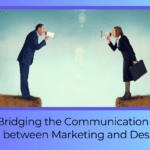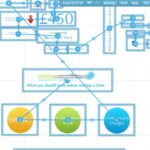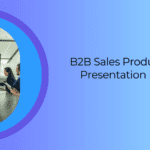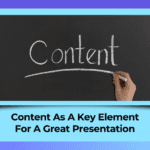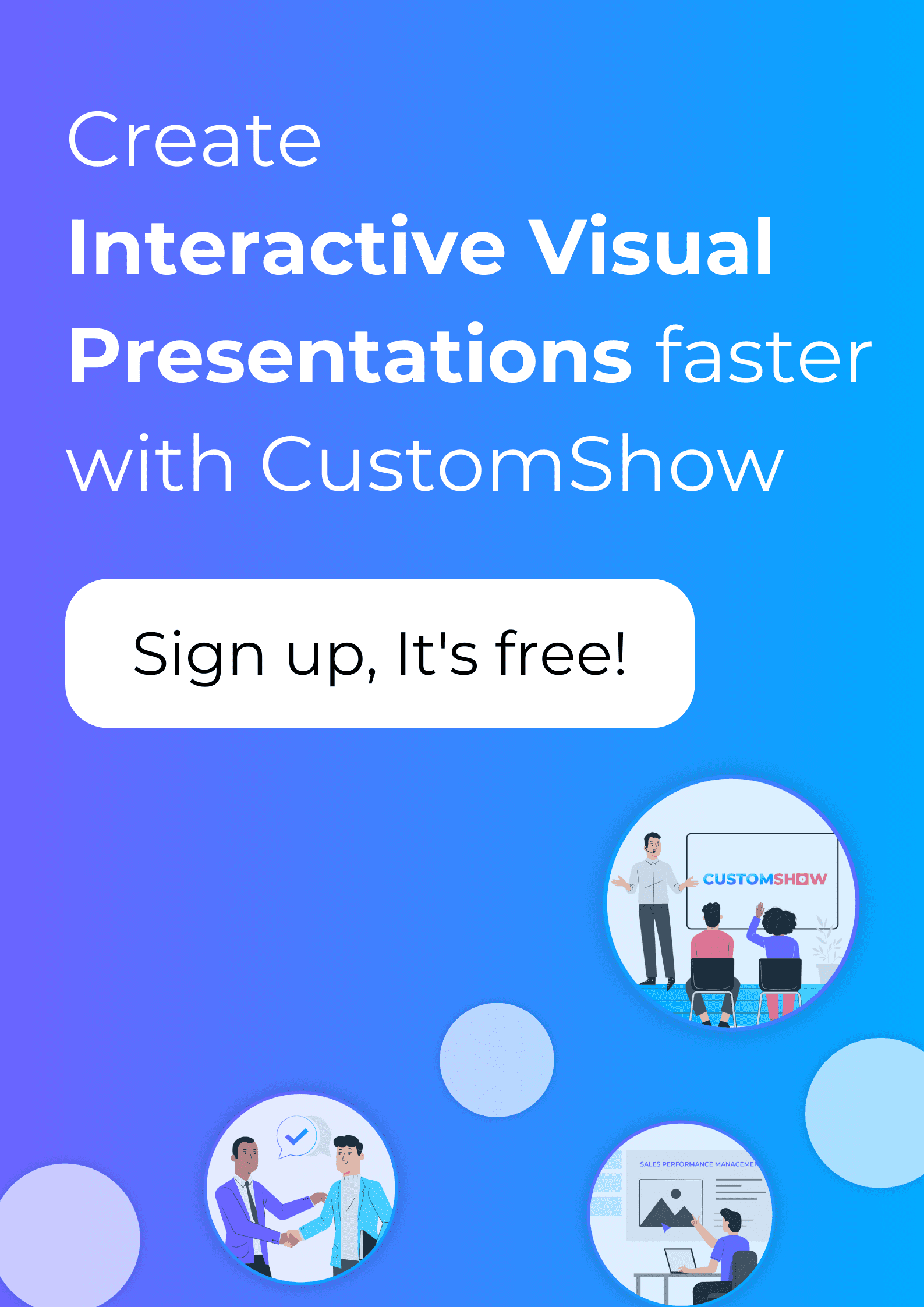What makes a GREAT presentation? We’ve all seen presentations and they run the gamut from good to bad to ugly. But what goes into making a presentation GREAT? Is it the design? The content? The structure? The speaker? Let’s find out the 4 keys to great presentations for businesses.
I’d like to suggest that it’s all of those things and go even further to say that a great presentation needs all 4 key elements to be great. Just having one or two or even three of these elements is nice, but for a presentation to be GREAT, you need all 4 key elements: Content, Design, Structure and Delivery.
We’ve been building and delivering presentations at CustomShow for over a decade and at Sales Graphics for 40 years before that, so we’ve seen our share of presentations. We’ve also seen and heard experts talk about the various elements that go into dynamic presentations and their relative merits, and we’ve learned a lot from the dynamic presentations and presenters we’ve worked with over the years. And what we’ve learned is building a GREAT presentation isn’t easy, but it can be broken down into 4 understandable elements. And once you understand the elements, the building becomes a lot easier.
So here we go:
The 4 Keys to GREAT Presentations:

Content: Every presentation needs to start with the right content.
- First, have a clear message. Make sure you know what you’re trying to say, whether it’s convincing a sales prospect of the value of your product or service, a trainee of the value of learning a process or skill, an audience of the importance of your cause or an investor in the value of your idea.
- Second, support your message with the best fonts, facts, and NPS tools. Facts can be data, NPS survey results, testimonials, photographs, or personal experience. Supporting your message gives you credibility and engages the audience on a deeper level, silencing that little voice in their heads that questions bald statements.
- Finally, curate your content. Make sure you only use what you need, what’s relevant, and what you can support. For that, you can hire any content marketing. Too much information is worse than too little. Better to engage your audience and leave them with questions than to bore or overload them so they tune out. If you have lots of data, pick the most compelling or most relevant. If you have a great personal story, whittle it down to its essentials so you can tell it concisely.
Design: Everything is designed for clarity and consistency.
- With presentation design, there is often confusion between beautiful design and effective design. While beautiful design is nice to have, it’s not essential to a creative presentation. Effective design is essential. Effective design makes your content clear, leads viewers along the path of your argument or story and reinforces your brand. Effective design looks great, but you don’t need to be an artist to create it. You just need to have a clear idea of your message, your audience and your delivery.
- Just as you need to curate your content, you need to curate your visuals. Too much visual information is just as bad as too much data or a story that goes on and on. Eliminate any visual elements that don’t reinforce your message.
Structure: Everything is in its place, both in the presentation and out.
- Presentations are stories told in time, and as such they need to have a beginning, middle end. Just the fact that you start your presentation, talk for a while and then finish doesn’t count as structure, however. The work of curating and supporting your content and design elements will give you a clearer idea of how best to structure your story, and there are lots of valuable resources out there to help with picking a narrative structure. Luckily, a presentation isn’t a post-modern novel, so complex narrative structures aren’t necessary. But introducing the premise, promise, or problem that is the core of your message and then describing, supporting and solving or delivering your solution is critical.
- Presentation structure, unlike other documents or interactions, also needs to be structured with the audience in mind. A great presentation is targeted to its audience, both in terms of message and content. Does the narrative speak to the experience of this audience? Is the call-to-action targeted to this particular audience’s needs? Are the data, demos, products, competitive sets, or case studies targeted for the objectives of today’s meeting instead of yesterday’s or tomorrow’s?
- The structure can also apply to your entire Library of presentation materials. If you’ve been giving any type of presentation for a while, or your company has a shared drive full of presentations, there’s a lot of available content for you to work with. The question is whether you can find valuable and appropriate content for the presentation branding you’re working on. Applying the idea of structure and organization to not just your presentation but to your Library of previous presentations and presentation materials can be just as important as structuring your information within your presentation. Being able to efficiently find what you need and know that it’s accurate and up-to-date will make you a more effective presenter.
Delivery: It doesn’t mean a thing if it ain’t got that swing.

- All your great work on content, design and structure doesn’t mean a thing if no one sees it. Presentations aren’t merely documents or files; they are an experience shared between a presenter and their audience. A great presentation is only as good as the delivery, both by the presenter and by the presentation technology. Whether presenting in a boardroom, off an iPad, over the Web or as a print-out, the right delivery is the difference between a great presentation and, at best, a missed opportunity and, at worst, a presentation disaster. All the other elements don’t matter if the delivery doesn’t work.
- Delivery refers to how the Presenter delivers the presentation.
- Presentation skills are necessary for anyone who plans on making a living from presentations or whose business depends on giving effective presentations. We’ve worked with a wide range of presentation coaches and read a lot on the subject, and taking the time to find out more about your presentation skills and how they can be improved will always return results.
- But just as important as the Presenter’s skills is the platform and technology you use to deliver your presentation. The tool you use to deliver your presentation is one of the most overlooked elements of a presentation. Just as your content, design and structure need to match the situation and audience, how you deliver your presentation matters. Presenting to a boardroom full of senior executives requires a different tool than a one-on-one presentation over lunch and then a webinar or conference call. Oftentimes people pick the presentation tool that they’re most familiar with or just happens to be there (often PowerPoint), without thinking about what the presentation’s specific delivery needs are.
- There used to just be PowerPoint, whether you were handing out print-outs, presenting on a projector or emailing someone a follow-up. Today there is an explosion of presentation tools targeted to specific audiences and platforms. Which one is right for you depends on your content, your design and your audience. For businesses that rely on presentations to close business, we think it’s important to find a platform that supports both a wide range of content and design options as well as a wide range of structure and delivery options. iPad-only presentation apps are great for that particular audience but can’t be repurposed or extended to other situations. The same goes for desktop software that requires a laptop and can’t be collaborative or shared over the Web. Understanding how you need to deliver your presentations across your organization and choosing a platform that supports those delivery options can be the difference between an assortment of documents, data and design and a library of GREAT presentations.
These are our 4 Keys to GREAT Presentations, and we’ve seen that only having a few of them doesn’t work. If you just have great content you have a great spreadsheet, but you don’t have a presentation. If you only have an excellent design, you have some nice art, but you don’t have a presentation. Putting it all together is what makes it a presentation.
Read more on: What do you Need to Think About Before Designing the Presentation?
In future posts, we’ll go into each of these 4 Keys in more detail. We will give examples and ideas from our experience building and delivering presentations. With all the great information out there, and the great new presentation tools available. Everyone should be able to have a GREAT presentation. And this 4 Keys framework should help make that goal a little easier to understand and achieve.
Every good presentation is a good presentation builder that fits the intricacies and identity of your organization. At CustomShow, we believe our presentation software can do just that.
Read more on : When Creating a Presentation Based on Lots of Data, What Principle Should You Bear in Mind?
Read more on : How to Hand Over A Presentation to the Next Person?
Read more on: What is the Best Way to Deliver Presentations with Authenticity?

